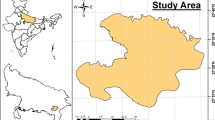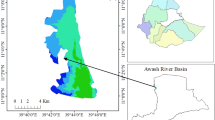Abstract
The use of the groundwater flow model is prevalent in the field of hydrogeology. The models have been used to address a variety of hydrogeological conditions including flow and transport of contaminants for risk evaluation. In the present study, a transient groundwater flow model for part of the Bemetara district of Chhattisgarh was developed to determine in detail the groundwater flow in the shallow and deep aquifer. The model simulates groundwater flow over an area of about 588 sq. km with a uniform grid size of 500 m by 500 m and contains two layers, 53 rows, and 68 columns. The visual MODFLOW software was used in this study to simulate groundwater flow. The conceptual model was built by analyzing the hydrogeological data. Based on the available data observed from 2015 to 2018, which provide insights to understand the dynamic behavior of groundwater systems and to predict spatial-temporal distributions of groundwater levels in responding to changes in the aquifer environment. 10 observatory wells within the study area were used for observation as well as calibration purposes. With the help of hydraulic conductivities and storage coefficients, the model has been calibrated with a normalized root mean squared of 7.477 % for steady-state & transient state NRMS is 9.242 %. The model has been forecasted for 2190 days up to the year 2024, suggests the depletion of the water table with an average annual fall of about 50cm, which indicates the overall projected depletion of the water table by 2024 will be 2.5–4 meters in different place of the study area. To mitigate this hazardous condition 15% reduction in the pumping of groundwater and the establishment of a total of four recharge wells has been suggested.
Similar content being viewed by others
References
Akter, A. and Ahmed, S. (2021) Modeling of groundwater level changes in an urban area. Sustain. Water Resour. Manag., v.7(7). doi: https://doi.org/10.1007/s40899-020-00480-x.
Arunangshu Mukherjee, Ranjan Kumar Ray, Dinesh Tewari, Vijay Kumar Ingle, Bikram Kumar Sahoo and Khan, M.W.Y. (2014) Revisiting the stratigraphy of the Mesoproterozoic Chhattisgarh Supergroup, Bastar craton, India based on subsurface litho information. Jour. Earth Syst. Sci., v.123, pp.617–632.
Brown, P. L., Guerin, M., Hankin, S.I. and Lowson, R.T. (1998) Uranium and other contaminant migration in groundwater at a tropical Australian Uranium Mine. Jour. Contam. Hydrol., v.35(1), pp.295–303.
Census (2011) Chhattisgarh.Government of India, Ministry of Home Affairs. CGWB (2014) Central Ground Water Board, NCCR Raipur. State Hydrogeological Report Chhattisgarh. Govt. of India.
CGWB (2016–17) Groundwater year book Chhattisgarh Central Ground Water Board 7, 82.
D’Affonseca, F.M., Finkel, M. and Cirpka, O.A. (2020) Combining implicit geological modeling, field surveys, and hydrogeological modeling to describe groundwater flow in a karst aquifer. Hydrogeol. Jour., v.28, pp.2779–2802. doi: https://doi.org/10.1007/s10040-020-02220-z.
Doherty, J., Brebber, L. and Whyte, P. (1994) PEST: Model-independent parameter estimation. User’s manual. Watermark Computing, Corinda, Australia.
GEC. (1997) Groundwater Resources Estimation Committee report of the groundwater resources estimation methodology. Government of India, New Delhi, pp.107.
Kumar R. and Harender R.A. (2013) Mitigation of groundwater depletion hazards in India. Curr. Sci., v.104, pp.10–25.
McDonald, M.G. and Harbaugh, A.W. (1988) A modular three-dimensional finite-difference ground-water flow model.USGS 6A, pp.89.
Nayak, P.C., Vijaya Kumar, S.V. and Rao, P.R.S. (2017) Recharge source identification using isotope analysis and groundwater flow modeling for Puri city in India. Appl. Water Sci., v.7, pp.3583–3598. doi: https://doi.org/10.1007/s13201-016-0497-x.
Rejani, R., Jha, M.K., Panda, S.N. & Mull, R. (2007) Simulation Modelling for Efficient Groundwater Management in Balasore Coastal Basin, India. Water Resour. Manage., v.22, pp.23–50.
Sathe, S.S. and Mahanta, C. (2019) Groundwater flow and arsenic contamination transport modeling for a multi aquifer terrain: Assessment and mitigation strategies. Jour. Environ. Manage., v.213, pp.166–181.
Saber Farhadia et al. (2016) An agent-based-nash modeling framework for sustainablegroundwater management: A case study. Agric. Water. Manag., v.177, pp.348–358.
Sahoo, S. and Jha, M.K. (2017) Numerical groundwater-flow modeling to evaluate potential effects of pumping and recharge: implications for sustainable groundwater management in the Mahanadi delta region, India. Hydrogeol. Jour., v.25, pp.2489–2511. doi: https://doi.org/10.1007/s10040-017-1610-4.
Senthilkumar, M. and Elango, L. (2004) Three-dimensional mathematical model to simulate groundwater flow in the lower Palar River basin, Southern India. Hydrogeol. Jour., v.12(4), pp.197–208. doi: https://doi.org/10.1007/s10040-003-0294-0.
Siva Prasad, Y., Venkateswara Rao, B. and Surinaidu, L. (2020) Groundwater flow modeling and prognostics of Kandivalasa river sub-basin, Andhra Pradesh, India. Environ Dev Sustain., v.23, pp.1823–1843. doi: https://doi.org/10.1007/s10668-020-00653-w.
Vetrimurugan, E., Senthilkumar, M. and Elango, L. (2017) Solute transport modelling for assessing the duration of river flow to improve the groundwater quality in an intensively irrigated deltaic region., Internat. Jour. Environ. Sci. Tech., v.14, pp.1055–1070, doi: https://doi.org/10.1007/s13762-016-1211-0.
Yehia, M.M., Monem, M., Mansour, N. M., and El-Fakharany, M. A. (2013) Using Modflow and MT3D Groundwater Flow and Transport Models as a Management Tool for the Quaternary aquifer, East Nile Delta, Egypt. Internat. Jour. Sci. Comm. Humanit., v.1(5), pp.219–233.
Author information
Authors and Affiliations
Corresponding author
Rights and permissions
About this article
Cite this article
Gobinath, M., Sahu, S.K., Ram, P. et al. Groundwater Flow Modeling Study to Assess the Sustainability of Groundwater Resource in and Around Bemetara Block, Chhattisgarh, India. J Geol Soc India 98, 712–719 (2022). https://doi.org/10.1007/s12594-022-2048-4
Received:
Accepted:
Published:
Issue Date:
DOI: https://doi.org/10.1007/s12594-022-2048-4




